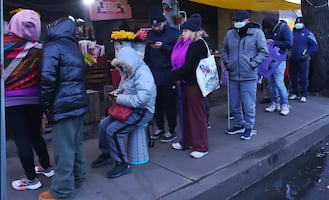Fatigue
, fever , cough , headache , loss of smell and, less often, serious lung damage ... The symptoms of COVID-19 , mostly mild, vary from patient to patient but seem well characteristic of the new coronavirus that our immune system does not know.
Highs and lows
One of the characteristics of the COVID-19 is its fluctuating appearance, underline doctors interviewed by AFP.
"When you have the flu , you are at the bottom of your bed for a few days and afterward you generally get better and better. In this case, the patients get better one day, the next day they’re feeling bad . It is very surprising. On 25 years of experience, I have never seen that,” explains Marianne Pauti , a general practitioner in Paris .

"They have the impression of not seeing the end of the tunnel," says an occupational doctor in Paris. It is important that patients are warned of this development so that they rest , even if they feel better, insists this doctor.
Recommended: COVID-19 FAQs
Another distinctive sign: Entry into the disease occurs fairly gradually , unlike the flu, for example, which manifests suddenly.
Typically, symptoms last two weeks or more - sometimes less. And the aggravation can occur in a second time.
Loss of smell
Anosmia
, or the sudden loss of smell, is a recently spotted symptom.
Doctors have detected numerous cases of people presenting only this symptom, without having a blocked nose . "It seemed weird," says to AFP Dr. Alain Corré , ENT at the Rothschild Hospital-Foundation in Paris. With Dr. Dominique Salmon of the Hôtel Dieu , they tested around sixty anosmic patients: 90% were positive.
The loss of smell would seem to be a pathognomonic symptom , that is to say, a clinical sign which, by itself, makes it possible to establish the diagnosis. And at this stage, it is the only specific presentation of the new coronavirus . "In the current context, if you have anosmia without a stuffy nose, you are COVID positive , it is not worth going to get tested," says Dr. Corré.
Recommended: COVID-19: How to take care of your mental health during the coronavirus outbreak
It is, therefore, necessary to isolate oneself so as not to contaminate others, but in itself, the symptom is nothing serious.
The SARS Cov-2 virus is attracted to the nerves: when it enters the nose, instead of attacking the mucosa as other viruses do, it attacks the olfactory nerve and blocks odor molecules, explains the Dr. Corré. The infringement would a priori be local.
Fatigue and headache
Asthenia is frequently described. "I always hear the same thing: exhausted patients; they take three steps and have to lie down," says Dr. Pauti. It is often accompanied by a headache .
Fever and body aches
The SARS Cov-2 virus can cause flare-ups , which are fluctuating and usually a little weaker than with other viral syndromes.
Many also complain of aches , classic of a viral attack but often more painful , and more localized.
Recommended: COVID-19: Myths vs Facts
Cough
A dry cough , sometimes with a sore throat and runny nose , can also be suggestive of the disease.
Bowel disorders
Some patients have diarrhea , more rarely nausea. But "these symptoms alone are not enough to diagnose the disease," says Dr. Pauti.
Lung damage
When the virus hits the lungs , the pain is variable. The most-reported feeling is to have the lungs "in a vice". Others fear that they will no longer be able to take in air, "which can be aggravated by anxiety , especially in isolated people", according to city doctors.
The infection becomes worrisome when people "breathe faster than normal," reports Dr. Pauti, who asserts that is the time to call emergencies.
A brutal aggravation can occur between the 7th and the 14th day, in the form of bilateral pneumonia , with a very particular radiological aspect. "On CT, you can be almost certain" that it is the COVID-19, explains Pauline, hospital doctor in the Paris region.

She notes in most of the hospitalized patients "an incredible clinical tolerance : they do not suffocate at all whereas they have catastrophic parameters with the gasometry ,” which measures the oxygen level in the blood.
Recommended: COVID-19: Mexico must prevent the collapse of its health system
"When it gets worse, it happens suddenly," says this doctor. It is then severe acute respiratory distress - a syndrome observed during SARS , and even to a lesser extent, influenza.
In resuscitation, the respirator can allow you to pass the course, but the situation can deteriorate further, and lead to death, without anyone knowing why. "It's probably a general runaway of the inflammatory system , purely viral - there are few bacterial secondary infections," she analyzes.
"The drama of this virus is that it strikes a naive population, 100% receptive " since our immune system has never encountered it.
Recommended: COVID-19: Mexico's federal government temporarily suspends its activities
mp
Noticias según tus intereses
[Publicidad]
[Publicidad]














